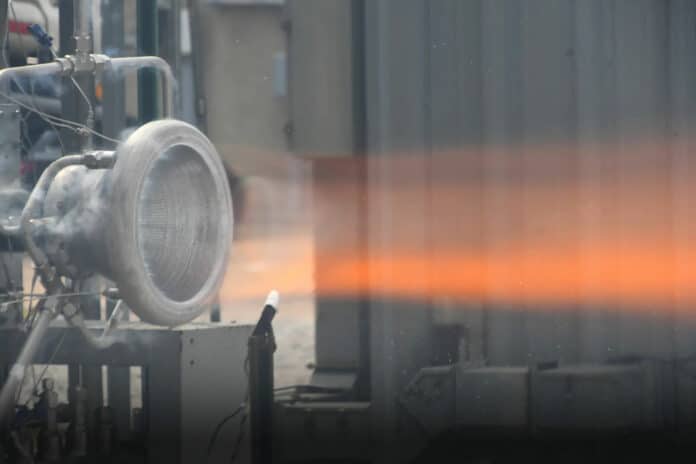One of the main challenges of sending humans to the Moon, Mars, and beyond is the capability of carrying enough supplies to ensure their survival. To achieve that, it is essential to cut down the weight of the rocket itself as much as possible so that it can carry more cargo.
This requires finding lightweight materials that can withstand the harsh conditions of space travel. NASA is currently competing to develop such materials and has already achieved some promising results.
One of the recent achievements is the development and testing of a 3D-printed rocket engine nozzle made of aluminum, which is lighter than other nozzles used in conventional rocket engines and opens up new possibilities for deep space flights that can carry more payloads.
The component’s development is part of NASA’s Reactive Additive Manufacturing for the Fourth Industrial Revolution (RAMFIRE) project.
Aluminum has a lower density and a higher strength-to-weight ratio than most metals, making it ideal for lightweight, high-performance components. However, aluminum also has drawbacks, such as its low tolerance to extreme heat and its tendency to crack during welding. That’s why aluminum is not typically used for additive manufacturing of rocket engine parts – until now.
Recognizing its potential, engineers from NASA’s Marshall Space Flight Center partnered with Elementum 3D to create a weldable type of aluminum that is heat-resistant enough for use on rocket engines.
The 3D-printed RAMFIRE nozzles are designed with small internal channels that keep the nozzle cool enough to prevent melting. In addition, the RAMFIRE nozzle is built 3D printed as a single piece, requiring far fewer bonds and significantly reduced manufacturing time. For comparison, traditionally manufactured nozzles may require as many as a thousand individually joined parts.
NASA and Elementum 3D have developed a novel aluminum variant known as A6061-RAM2 and specialized powder for use in the laser powder direct energy deposition (LP-DED) process. Another commercial partner, RPM Innovations (RPMI), used the newly invented aluminum and specialized powder to build the RAMFIRE nozzles using their LP-DED process.
“We’ve reduced the steps involved in the manufacturing process, allowing us to make large-scale engine components as a single build in a matter of days,” said Paul Gradl, RAMFIRE principal investigator at NASA Marshall Space Flight Center.
The novel alloy could play an instrumental role in NASA’s Moon to Mars objectives by enabling the manufacturing of lightweight rocket components capable of withstanding high structural loads.
At Marshall’s East Test Area, two RAMFIRE nozzles underwent several hot-fire tests with liquid oxygen and liquid hydrogen and also with liquid oxygen and liquid methane fuel configuration. The nozzles endured pressure chambers above 825 pounds per square inch (psi), which exceeded the expected testing pressures, and achieved 22 starts and 579 seconds, or almost 10 minutes, of run time. This event shows that the nozzles can function in the most challenging deep-space conditions.
“This test series marks a significant milestone for the nozzle,” Gradl said. “After putting the nozzle through the paces of a demanding hot-fire test series, we’ve demonstrated the nozzle can survive the thermal, structural, and pressure loads for a lunar lander scale engine.”
In addition to successfully building and testing the rocket engine nozzles, engineers have also utilized the RAMFIRE aluminum material and additive manufacturing process to create other advanced large components for demonstration purposes. These include a 36-inch diameter aerospike nozzle with complex integral coolant channels and a vacuum-jacketed tank for cryogenic fluid applications.
